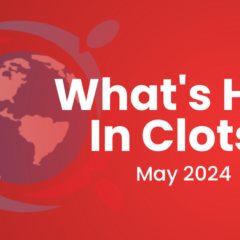Last updated on
Clot Chronicles: The APEX Trial with Dr. James Welker
Dr. James Welker, a special guest host of the Clot Chronicles, discusses the groundbreaking APEX trial and the impact it will have on the care of hospitalized patients.
For Dr. Welker’s full input, read below:
Hello, this is Dr. James Welker and I’m the Director of Vance Medical Therapeutics at Anne Arundel Health System. Today I have the honor of discussing the APEX Trial as a guest host for this episode of the North American Thrombosis Forum’s Clot Chronicles.
I view the prevention of illness as the ultimate goal of healthcare. While most diseases are treated only after the patient has acquired the illness, certain illnesses give us the opportunity for prevention. Due to its association with pre-cursor events, VTE (venous thromboembolism) offers this opportunity of prevention in specific patient populations.
Although hospitalization is a known risk factor for VTE, nearly seventy-five percent of VTEs occur as outpatients and in nearly half of patients were in the hospital in the last ninety days. So, this suggests that we need prophylaxis both for inpatients and outpatients following a recent hospitalization.
For more than two decades guidelines have advised for the use of anticoagulants for the prevention of VTE during hospitalization and these guidelines recommend this both for patients undergoing surgery and those hospitalized for medical illness.
For surgical patients, receiving either lower extremity joint replacements or those having certain cancer surgeries, it’s recommended that they continue anticoagulants for an entire month following hospitalization. However, at this time the guidelines recommend against post-hospitalization prophylaxis for patients hospitalized for acute medical illness.
This is based on the most rigorously performed trials that include the EXCLAIM Trial, the ADOPT Trial, and the MAGELLAN Trials. These trials assessed enoxaparin, apixaban, and rivaroxaban for patients with a recent hospitalization due to acute medical illness. Overall, when the data was combined to assess efficacy and safety with major bleeding events, in total there was no overall benefit for patients and as such they have not been added to the guidelines.
With recognition that the portion of patients suffering DVT needed concentrated to avoid unnecessary treatment of low risk patients and the selected treatment must have a minimal bleeding risk, the APEX trial was designed based on the foundation of data from these prior trials.
Betrixaban was considered a potential candidate due to its unique pharmacokinetics that reduce the fluctuations in serum concentration and provide hope that this would translate into a reduction in bleeding events. The APEX trial included the typical hospitalized medical population. That includes patients suffering from infection, heart failure, respiratory failure, ischemic stroke, and hermetic disease.
The data from the prior trials was used to select the enrollment criteria that would enrich the population to have a high rate of VTE. These criteria include:
- Patients that are over seventy-five. They in and of themselves have a high enough rate of VTE.
- Patients between sixty and seventy-five. In order to select out patients with a high rate of VTE they used a D-dimer elevation greater than two times upper limit to normal or additional risk factors.
- Then the patients between the age of forty and sixty their rate of VTE was only high enough if they had had one of the key underlying risk factors that are most strongly associated with VTE: being prior VTE or cancer. Then they also in addition had to have D-dimer elevation or other risk factors present.
Typical risk factors we think of include prior VTE, BMI greater than thirty-five, thrombophilia, hormone replacement therapy, and so forth.
Notable excluded patients include those with a GFR less than fifteen, those taking dual antiplatelet therapy, and those with some other reason to have an increased bleeding risk.
Patients were randomized to enoxaparin for six to fourteen days, consistent with guideline recommended course of VTE prevention. And that was compared to betrixaban for a course of thirty-five to forty-two days. That was begun while the patient was in the hospital and continued for that duration after hospitalization as an outpatient.
The primary efficacy endpoint was a composite of VTE related death, PE, and DVT whether it was symptomatic or asymptomatic. The primary safety endpoint was major bleeding, and the patients were followed for almost three months following their hospitalization.
What did they find? The primary efficacy outcome was reduced from 6 percent in enoxaparin group to 4.4 percent in the betrixaban group. This was a twenty-five percent risk reduction, a number needed to treat of sixty-three to prevent one thrombotic event.
The primary safety outcome was no difference between the two groups with a major bleeding event rate of 0.57 percent versus 0.67 percent.
So, overall there was a reduction in the rate of VTE without an increase of major bleeding and based on this data, in 2017, betrixaban was the first anticoagulant to receive FDA approval for prophylaxis of VTE in adult hospitalized patients for acute medical illness that included data positive with a treatment that extended beyond the hospitalization.
So, that does this mean for the clinician? Well, for the first time we have an option for the prevention of VTE in those patients recently hospitalized for acute medical illness. It defines the population of patients that are at sufficiently elevated risk since they may benefit from post hospitalization prophylaxis. It also defines the population that’s at a sufficiently low bleeding risk, that they may safely receive treatments.
We should keep in mind that while this is the first anticoagulant to have no increased risk of major bleeding in this clinical trial patient population, this population was selected to be a low bleeding risk and we would want to select similar patients as we choose to treat them while providing routine medical care.
Overall, this represents a significant improvement in healthcare and that clinicians can now consider whether their patients who are hospitalized for acute medical illness are at sufficiently increased risk of VTE and sufficiently low risk for bleeding since they may benefit from the use of betrixaban for a month after discharge from the hospital and consider offering such patients this new option for prophylaxis.
So, hopefully we’ll overall see future reductions in rate of VTE in society.
This is Dr. James Welker signing off for the NATF Clot Chronicles.



